Soil Management: Soil and Water Conservation Management
[addw2p name=”soilMgmtGeneral”]
Erosion and run-f commences with the dispersions or breakdown of soil particles in topsoil from the impact of rain. The dispersed soil particles and the usually more compact sub-soil slow down infiltration of the rain water into the soil. This accelerates and increases run-off which occurs when rate of rainfall exceeds infiltration rate of water into the soil. Loss of topsoil not only reduces soil fertility but also means lower water-holding capacity of the soil.
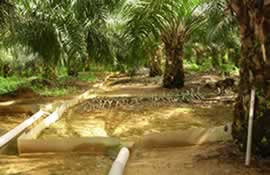
Erosion plots

AAR – Felda agronomists beside leaching column
In Malaysia, soil erosion under oil palms on slopes of 4 to 7 was measured at 6 to 13 t ha-1 yr-1 (Maene et al ., 1979; Lim, 1990) compared to jungle area at 0.31 t ha-1 yr-1 (Maene and Sulaiman, 1980). Factors which affect the rate of soil loss are rainfall, rate of run-off, soil types, slope, plant cover and presence or absence of conservation measures.
The main objectives of soil and water conservation are to obtain the maximum sustained level of production from a given area of land by preventing soil degradation and environmental pollution. Therefore, soil conservation practices usually aim at the primary causal factors and areas. For example, reducing or protecting bare areas or exposed soil and reducing the rate of run-off. Timing in implementation of soil conservation measures is also important in plantation tree crops, as the highest risk of erosion usually occurs in specific period such as during planting or replanting and monsoon season.
Soil conservation practices should be considered in the following situations also :
- strongly sloping or rolling areas and steeper (8 or more), particularly where slopes are long,
- highly erodable soils especially in areas with slopes about 6o. Such soils are usually sandy, with weak structure and low in organic matter such as Malau series and Kapilit Family soils,
- areas with poor crop canopies and bare soil or sparse ground cover conditions,
- areas with high and frequent intense rainfalls of more than 25 mm hr-1,
- shallow soils (less than 50 cm) and compacted soils areas.
Lim et al . (1994) suggested that soil and water conservation measures should be implemented on slopes of 30 or more but this has not been adopted by most plantation companies.
The following soil conservation practices should be considered for application in appropriate situations, depending on the specific erosion risks posed in the areas.
Terracing
Generally, there are two kind of terraces, that is, planting terraces and conservation terraces. The former is constructed mainly to facilitate harvesting, crop evacuation and maintenance operation apart from conserving soil and water. Planting terraces should slope inwards and there should be a vertical drop of about 50 cm between the lip and the rear of the terrace to trap run-off water. Regular stops along the terraces are also necessary for the same purpose.
The dimensions of terraces depend on the crops, planting density, slopes and whether future mechanisation will be implemented. In general, the terraces for oil palms should be more than three metre wide and the horizontal distance between two adjoining terraces (6.5 to 9.5 metres) will depend on the planting distance along the terrace and planting density. Similarly for rubber except that the terrace width is generally smaller at 2 metres or more. For cocoa, planting terraces are seldom constructed although it is now highly recommended. The terraces should be 2.5 to 3.5 metre wide with about 12 metres horizontal distance between two adjoining terraces. There is one terrace in every 3rd cocoa row; the other cocoa trees are planted on platforms.
Long slopes which are less than 8 or short rolling to hilly slopes may require conservation terraces instead. They should be cut at approximately 30m intervals, primarily to reduce the length of slope. If platforms are made, they should be about 1.5m x 1.5m for oil palms and 1m x 1m for cocoa.
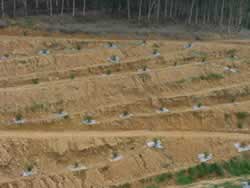
Terracing
Establishment of leguminous cover crops
In cocoa, it is generally not a recommended practice to establish leguminous cover crop. The creeping habit of legumes and high stand of cocoa will make it difficult to maintain. However, other desirable ground vegetation should be kept as discussed in the next section.
In oil palms and cocoa, it is important to establish the legumes to reach full ground coverage as rapidly as possible after land preparation where threats of erosion and land degradation are most real. Ling et al (1979) showed that soil loss on a 10 gradient Munchong series can be 8 folds higher on bare soil compared to legumes or natural covers (Table 3). This is even more important where the effective soil depth is already shallow. Furthermore, Ling et al (1979) reported that soil loss was reduced from 9.0 t ha-1 yr-1 at 0-30% ground coverage to 0.1 t ha-1 yr-1 at 90-100% ground coverage (Table 4). Similar marked reduction in run-off losses were also obtained. Moreover, the other beneficial effects of legumes on soil fertility, soil physical properties and soil biological activities are well-known.
|
Vegetation |
Rainfall (mm) |
Run-off (mm) |
Run-off (% rainfall) |
Soil loss (t ha-1 yr-1) |
|
Bare soil |
1854 |
236 |
15 |
79 |
|
Legumes |
1854 |
70 |
5 |
11 |
|
Natural cover |
1854 |
61 |
3 |
10 |
|
Vegetation |
Ground cover |
|||||
|
0 – 30 % |
90 – 100 % |
|||||
|
Rainfall (mm) |
Run-off (mm) |
Soil loss (t ha-1 yr-1) |
Rainfall (mm) |
Run-off(mm) |
Soil loss (t ha-1 yr-1) |
|
|
Bare soil |
269 |
57 |
13.5 |
287 |
64 |
11.3 |
|
Legumes |
269 |
47 |
9.0 |
287 |
3 |
0.1 |
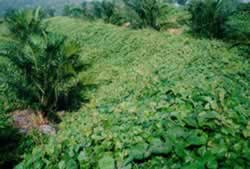
Good legume covers
Maintaining ground vegetation
Table 3 shows that natural covers which are not competitive for nutrients and water can be used to reduce soil erosion and run-off losses. This will improve soil moisture balance compared to bare soil conditions.
Good maintenance of ground covers is especially important in cocoa where legume covers are not established. In the other tree crops, they should be encouraged to gradually succeed the legumes as the latter dieback due to shading effect.
 Good Ground Cover – Nephrolepis |
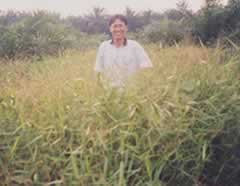 Poor ground cover – thick grasses |
Frond stacking
In mature oil palms there is an additional opportunity to correctly stack the pruned fronds across the slope and cover as much ground area as possible to help in reducing the run-off and erosion losses substantially. This was demonstrated by Maene et al . (1979) on Durian series with mature oil palms on 5 to 9% slopes (Table 5). In terraced areas, pruned fronds placed across the terrace width at regular intervals will also assist to break the flow of run-off water.
| Position in field |
Nutrient loss as % of fertilizer nutrients added |
|||||
|
N |
P |
K |
Mg |
Ca |
B |
|
| Oil palm row |
13.3 |
3.5 |
6.0 |
7.5 |
6.8 |
22.9 |
| Harvest path |
15.6 |
3.4 |
7.3 |
4.5 |
6.2 |
33.8 |
| Pruned frond row |
2.0 |
0.6 |
0.8 |
2.7 |
0.8 |
3.3 |
| Pruned frond/harvest path |
6.6 |
1.4 |
3.5 |
2.2 |
3.4 |
12.5 |
| Average for the field |
11.1 |
2.8 |
5.0 |
5.6 |
5.2 |
20.7 |
| Nutrient from fertiliser applied (kg ha-1) |
90.2 |
52.0 |
205.9 |
32.8 |
78.9 |
2.4 |
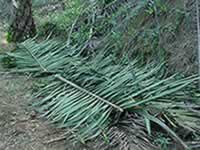
Frond stacking
Mulching with empty fruit bunches (EFB)
Wherever EFB is available, it can be suitably used for mulching especially in new plantings. The mulch will :
- minimise erosion and run-off losses of the bare soil,
- reduce soil moisture evaporation loss during the dry months (Lim and Messchalch, 1979),
- supply nutrients to the planted seedlings,
- improve soil conditions.
Fresh EFB can contain high soluble salts and it is best to keep the EFB until part of the soluble salts are washed or leached off by rain before application to cocoa, which is sensitive to high conductivity.

EFB mulching
Silt pits
In some areas, soil erosion and run-off may be very severe even with the construction of soil conservation and planting terraces. For such special areas, the digging of silt pits may be helpful as shown by Lim et al . (1994). However, yield response to silt pitting has not been established.
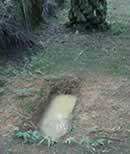
Silt pit
Soil Management: Soil Requirements of Plantation Tree Crops
[addw2p name=”soilMgmtGeneral”]
The first approach in good soil management is to attempt to match the crop requirements with soil properties, with or without amendments. Water and nutrients are probably the most limiting agronomic factors to growth and yield of plantation tree crops (Goh and Chew, 1994). This is because tropical environments usually provide sufficient and uniform sunshine for crop production. It is well known that the above limiting agronomic components are available to plants via the soils. However, to tap into water and nutrients efficiently, the plants need to have good rooting activity.
Rooting activity is influenced by many soil properties such as terrain, soil depths, stoniness, texture, structure, consistence, permeability, drainage and nutrients. These properties generally act in an interactive manner and an understanding of this dynamics is necessary to elevate the yield curve. Therefore correct identification of the types of soil limitations present is vital to soil management.
We also need to assess the severity of the identified soil properties which are limiting yield performances. Overcoming or alleviating them should upgrade the yield performances. It also enables proper formulation and implementation of specific soil management practices in each field in order to maximise return, avoid soil degradation and prevent environmental pollution.
The soil properties and their criteria for assessment of severity of their limitations for plantation tree crops are provided in Appendices 1 to 3 and briefly discussed below.
|
Soil properties |
Desirable range |
Minor limitation |
Serious limitation |
Very serious limitation |
|
Terrain ( ° ) |
0 – 12 |
12 – 16 |
16 – 24 |
> 24 |
|
Effective soil depth (cm) |
> 90 |
60 – 90 |
30 – 60 |
< 30 |
|
Stoniness (%) |
0 – 5 |
5 – 20 |
20 – 40 |
> 40 |
|
Consistence |
friable-moderately firm |
firm |
very firm – loose |
compact |
|
Texture |
sandy clay loam, clay loam or heavier |
loam, sandy loam |
loamy sand |
sand |
|
Structure |
well developed |
moderately developed |
very weak or massive |
structureless |
|
Nutrient status |
low fertiliser requirements |
moderate fertiliser requirements |
high fertiliser requirements |
very high fertiliser requirements |
|
Permeability (drainage) |
Moderately well to well drained |
imperfectly drained |
poorly or excessively drained |
very poorly drained |
|
Water table (depth in cm) |
75 – 90 |
60 – 75 |
30 – 60 |
< 30 |
|
Soil pH |
> 4.0 |
3.5 – 4.0 |
3.0 – 3.5 |
< 3.5 |
|
Conductivity ( mhos/cm) |
< 1000 |
1000 – 1500 |
1500 – 2500 |
> 2500 |
|
Sulphidic layer (depth in cm) |
> 90 |
60 – 90 |
30 – 60 |
< 30 |
|
Peat (depth in cm) |
< 30 |
30 – 100 |
100 – 150 |
> 150 |
|
Soil properties |
Desirable range |
Minor limitation |
Serious limitation |
Vey serious limitation |
|
Terrain ( ° ) |
0 – 6 |
6 – 12 |
12 – 20 |
> 20 |
|
Effective soil depth (cm) |
> 90 |
75 – 90 |
45 – 75 |
< 45 |
|
Stoniness (%) |
0 – 5 |
5 – 20 |
20 – 40 |
> 40 |
|
Consistence |
friable-moderately firm |
Firm |
very firm – loose |
compact |
|
Texture |
sandy clay loam – clay |
loam, sandy loam |
loamy sand |
sand |
|
Structure |
well developed |
moderately developed |
very weak or massive |
structureless |
|
Nutrient status |
low fertiliser requirements |
moderate fertiliser requirements |
high fertiliser requirements |
very high fertiliser requirements |
|
Permeability (drainage) |
Moderately well to well drained |
imperfectly drained |
poorly drained |
very poorly drained |
|
Water table (depth in cm) |
75 – 90 |
60 – 75 |
30 – 60 |
< 30 |
|
Soil pH |
5.5 – 6.5 |
4.5 – 5.5 |
3.5 – 4.5 |
< 3.5 |
|
Conductivity (mhos/cm) |
< 500 |
500 – 1000 |
1000 – 2000 |
> 2000 |
|
Sulphidic layer (depth in cm) |
Unsuitable regardless of depth |
|||
|
Peat (depth in cm) |
Unsuitable regardless of depth |
|||
|
Soil properties |
Desirable range |
Minor limitation |
||
|
Texture |
Sandy clay loam to clay |
Sandy loam, silty clay |
Loamy sand |
Sand |
|
Effective soil depth |
> 100 cm |
60 – 100 cm |
30 – 60 cm |
> 30 cm |
|
Structure |
Strongly developed |
Moderately developed |
Weak or massive |
Very weak or massive |
|
Consistence |
Friable to moderately firm |
Firm |
Very firm |
Very firm |
|
Laterite/gravels |
Nil |
Nil |
25% nodular or fragmented latente 30 cm in thickness |
25% nodular or fragmented latente. > 30 cm in thickness |
|
pH |
4.5 – 5.5 |
4.0 – 4.5 |
3.5 – 4.0 |
> 3.5 |
|
Peat layer |
Nil |
0 – 30 |
30 – 60 cm |
> 60 cm |
|
Permeability |
Moderately well drained to well drained |
Imperfect drainage or very well drained |
poorly drained |
Very poorly drained or excessively drained |
|
Terrain |
0 – 12 |
12 – 23 |
23 – 30 |
> 30 |
|
Nutrient content |
High |
Medium |
Low |
Extremely low or extremely high in trace element |
Terrain
Under Malaysian land law, it is unlawful to cultivate land with slopes more than 20 or 36%. These lands are classified as steepland in Peninsular Malaysia. Such landforms are commonly found in Sarawak and Sabah also and may occur within the plantations. They are usually left unplanted, planted with forestry trees or if the area is small, may be planted with plantation tree crops.
The main problems caused by steep topography are
-
high risks on erosion, landslides and run-off losses of nutrients,
-
poor water balance due to excessive run-off,
-
the need to terrace implies the planting on less fertile sub-soil, which is commonly devoid of organic matter and generally firmer consistence,
-
difficulty in harvesting or tapping and field maintenance operations with probably poorer crop recovery.
Therefore, poor tree performances are not uncommon on steep slopes. However, the effect of slope seems to be less detrimental if the soils are fertile, such as with Kobovan Family soil in Sabah which is derived from basic volcanic parent materials. Rubber and cocoa trees are also less influenced by slopes probably due to easier harvesting operations, tap root system and lower nutrient demand.

Steep terrain – terraced planting
Soil depth and stoniness
Adequate soil volume is a prime requirement for root development. Soil volume is a function of soil depth and stoniness. In plantation effective soil depth is measured with an Edelman auger to an impenetrable layer within 90 cm depth while increase degree of stoniness will correspond to decrease in rooting space.
The main effects of shallow effective soil volume are :
-
limited root room for adequate amount of roots,
-
weak anchorage,
-
low available soil moisture,
-
low exploitable soil nutrients
In Sabah, stoniness is a less important factor because most rock fragments are loosely formed, partly weathered and mainly only stone sizes and sparse. Therefore, it does not form a continuous barrier to root penetration, development and activity unlike lateritic soils found in West Malaysia.
Under permanent moisture stress conditions as induced by poor rooting volume, cocoa will suffer from drastic wilt and defoliation (Hutcheon et al ., 1973) whereas in oil palms, the inflorescence abortion rate will increase and inflorescence differentiation will tend towards maleness. Lately, work at AAR also confirms that rubber growth and yield will decrease with poorer soil depth.
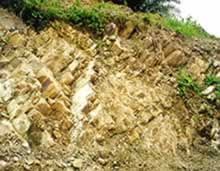
Stoniness – shallow soils
Texture, structure and consistency
These three soil physical parameters are closely related. They determined soil aeration (porosity), water holding capacity, permeability (infiltration), root penetrability and nutrient retention capacity. Unfavourable soil physical conditions inhibit root growth and function, leading to poor plant growth even under liberal applications of fertilisers (Soong and Lau, 1977).
Soil texture can significantly influence our management decisions. For example, in loamy soil to sandy loam soils such as Lintang series, with high percolation and low nutrient and water retention capacity, will need more frequent manuring and mulching to improve crop productivity and reduce environmental pollution. On the other hand, tillage should be avoided on heavy soils such as Briah series to avoid soil compaction which degrades the soils and reduces crop productivity (Cheong and Ng, 1974).
Apart from soils with firm to very firm consistence such as Durian and Batu Anam series soils, soil compaction can be caused by logging activities or use of heavy machineries. The hard pan left behind is difficult to break and establishment of sensitive crops such as cocoa is often unsuccessful.
The permeability of soils to water depends more on the structure with pore spaces than texture itself (Table 1). The implementation of poor permeability on crop growth is discussed in the next section.
|
Soil series |
Infiltration rate (cm hr -1) |
|||
|
0 – 15 cm |
15 – 30 cm |
30 – 45 cm |
45 – 60 cm |
|
|
Sungai Buloh |
115 |
55 |
30 |
23 |
|
Serdang |
26 |
31 |
27 |
15 |
|
Durian |
18 |
0.08 |
0.08 |
0.10 |
Structure also influence soil aerations, which if restricted can cause :
-
inhibited root development
-
impaired respiration of root system leading to reduced water and nutrient absorption
-
inhibited beneficial microbial activities.
Total porosity may differ only slightly between soils of different structure and texture (Table 2) but air-filled porosity (non-capillary pores) is generally better for sandy soils or soils with good structure and friable consistence such as Munchong and Serdang series. Experience indicates that crop growth can be severely limited if air-filled porosity falls to 2% of the total porosity (Soong and Lau, 1977). Soils with good structure are also less erosive and less proned to landslides. The latter is common in Sabah where the soils are generally younger and have weak structures.
| Soil series |
Porosity (%) |
|
|
Total |
Air-filled |
|
| Langkawi |
55 – 58 |
19 – 27 |
| Holyrood |
51 – 53 |
31 – 35 |
| Lunas |
51 – 53 |
24 – 27 |
| Sitiawan |
57 – 59 |
5 – 17 |
| Sogomana |
51 – 55 |
6 – 21 |
| Serdang |
50 – 52 |
24 – 30 |
| Segamat |
61 – 62 |
8 – 16 |
| Malacca |
58 – 60 |
10 – 14 |
| Jerangau |
57 – 58 |
6 – 10 |
| Senai |
58 – 63 |
2 – 19 |
| Harimau |
53 – 55 |
15 – 21 |
| Masai |
55 – 59 |
7 – 13 |
| Rengam |
53 – 56 |
12 – 20 |
| Durian |
63 – 65 |
19 – 27 |
Permeability and drainage
Permeability is generally associated with internal soil drainage and it is closely related to soil physical properties as mentioned earlier. Poor permeability can cause
-
perched water table such as in podzols
-
imperfect drainage even in hilly soils such as Batu Anam series,
-
poor rooting activity and its consequences as described earlier.
On flood plains and valley floors, high water table can be a common feature as in most Gleysols or Aquepts. Excessively high water table can give rise to :
-
inadequate soil aeration which hampers root respiration and causes poor nutrient and water uptake,
-
poor anchorage and lodging due to poor root development,
-
canopies turn chlorotic resulting in poor photosynthesis
Generally, oil palm is less influenced by poor permeability and drainage compared to cocoa and rubber.
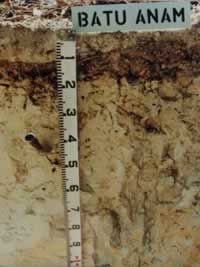 Poor permeablility |
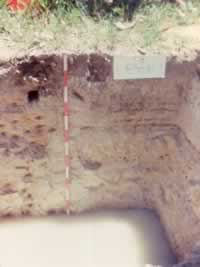 Poor drainage |
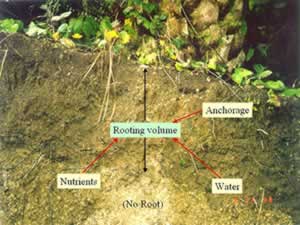
Root anchorage
Nutrient status
Malaysian soils have highly heterogenous inherent soil nutrient status (Goh et al , 1993). For example, Selangor series soils and young soil derived from basic volcanic rocks tend to have high soil fertility compared to sandy or highly weathered soils such as Munchong series. Moreover, soils in Sabah generally have high Mg content compared to West Malaysian soils (Goh et al , 1993).
Nutrients, being one of the two most limiting factors to crop productivity, must be correctly assessed to afford proper fertiliser management practices. Over- or under-application of fertilisers can have disastrous effects such as
-
poor crop productivity due to lack of fertiliser or imbalance,
-
less in profit due to excess fertilisation,
-
soil acidification and degradation,
-
environmental pollution due to excessive leaching and run-off losses.
Apart from acid sulphate soils, serious to very serious limitations on soil pH do not occur for oil palms and rubber. However, cocoa trees are more sensitive to soil acidity and liming to raise pH above 4.5 or exchangeable Al saturation less than 30% is usually necessary for optimum production.
Other soil limitations
The other soil limitations are generally associated with particular type of soils. These limitations are high salinity or conductivity in saline soils (Bakau series), sulphidic layer in acid sulphate soil and peat. These will be discussed in detail in part two of this lecture note and in tomorrow lecture on problem soils.
Soil management requirements for plantation tree crops
After going through the soil properties and their limitations, we can broadly summarise the major soil management requirements into:
-
soil and water conservation management,
-
soil fertility management,
-
soil acidity management,
-
soil water management,
as described by Cheong and Goh (1988). Soil and water conservation management also includes the amelioration and improvement of soil physical properties.
Soil Management: Principles of Soil Management
[addw2p name=”soilMgmtGeneral”]
Tropical environments provide unique conditions for the high yields of numerous crops, only if the right combinations of management, inputs and other factors influencing outputs per unit area and unit time are utilised (Pretty and Sanders, 1985). Soil management is one of the principal components of the above in the worldwide race between food production and population growth. Hence, it is not new and probably exists in tandem with the commencement of agriculture as recorded in writing dating back to 2500 B.C.
For many years, the main purposes of soil management are to maintain and improve soil fertility and synchronise soil productivity with and without enhancement, with crop requirements for high sustainable growth and yields. Therefore, we create soil conditions which are conducive to crop productivity (Kalpage, 1979) such as
-
good anchorage for crops,
-
ensure sufficient soil volume for rooting activity, and
-
supply adequate essential nutrients and water throughout each and every crop cycle.
These basic principles have served us well as shown by the present agricultural production which is in surplus worldwide although food distribution can be a problem.
Food surpluses have brought along not only low prices and cheap food policies which often favour politics (Johnston, 1995) but also concern for environmental pollution, soil degradation and non-sustainable agriculture. With increasing population and decreasing amount of land per capita, these threats can be real if our soils are ineptly managed. Thus, the present principles of soil management should encompass efforts to prevent such detrimental occurrences rather than a simple shift in paradigm to primarily tackle them. This is because the existence of mankind depends on an adequate supply of food and agricultural venture is a business concern.
We shall show that our present knowledge of plantation tree crops and soils has allow us to manage them in a sustainable manner and to do so in an environmentally acceptable way. This is probably central to our success in continuous cultivation of plantation tree crops on the same land at profitable level for many years.
Soil Management: General
[addw2p name=”soilMgmtGeneral”]
Introduction
The last 10 years saw a rapid expansion of land for plantation tree crops in south-east Asia, particularly in Malaysia and Indonesia. By 1993, Malaysia had 2.3 million hectares of oil palms, 1.8 million hectares of rubber and 0.4 million hectares of cocoa (Tay et al., 1995), which are growing by the days. Plantation tree crops are now cultivated on a diversified range of soils and landforms with increasing proportion of marginal soils. Our understanding of the physical, chemical and biological factors that control the fertility and productivity of soils has advanced greatly to allow us to exploit them effectively. In fact, an appreciation of this dynamic mechanism has led to an extensive use of soil information during this rapid expansion of oil palms in south-east Asia. The success story of our plantation industry owes partly to proper soil management practices, which evolved from both research and experience.
While good soil management has enable the continuous cultivation of plantation trees on the same land for over 3/4 of a century or after 3 generations of crops, poor soil management has dire consequences. For example, Goh and Chew (1994) showed that without manuring, the mean fresh fruit bunch (FFB) yield of oil palms was 32 t ha-1 yr-1 on Selangor series soil compared to 15 t ha-1 yr-1 on Rengam series soil. However, with manuring similar oil palm yields were obtained from both soil types. The increasing use of marginal land also dictates good soil management to ensure competitiveness and economic viability. This demands a correct identification of the types of soil limitations present and assessment of the degree of severity of each limitation in order to determine the most appropriate soil management practices required to fully exploit the yield potentials of the crops.
No agricultural system will be sustainable if it is not economically viable both for the farmer and the society of which he is a part (Johnston, 1995). Therefore, the importance of high early yields and sustainable yields from the economic stand point is obvious. Plantation tree crops being perennials, are subjected to large fluctuations in yields and prices of inputs and outputs. Coupled with the large investments and fixed costs involved in the industry, the maximum economic yield is usually at or near the site yield potential (Goh et al., 1994). There is now evidence to show that the inputs required to obtain the site yield potential do not necessarily endanger the environment, cause soil degradation nor reduce quality of the products (Chew et al.,1994a).
This paper, written in two parts, reviews the relevant soil management practices used in plantation tree crops for the humid tropics. Part one covers the general soil management practices while part two presents specific soil management practices to improve problem or marginal soils. This paper is restricted to oil palm, cocoa and rubber but the principles and practices should be applicable to most perennial tree crops.
Reference
Goh, K.J. and Chew, P.S. (1995). Managing soils for plantation tree crops. I. General soil management. In: Course on Soil Survey and Managing Tropical Soils (ed. Paramanathan, S.). MSSS and PASS, Kuala Lumpur: 228-245.
Note: The full list of references quoted in this article is available from the above paper.
Establishment: Concluding Remarks
Bearing in mind that an oil palm planting would have more than twenty years of productive life before it has to be replanted, the inputs at replanting and during the palm establishment period as mentioned in this article are highly justified. A well planted and well maintained stand of oil palm would reward the planter with sustainable high early and mature yields, provided the other agro-management requirements (such as nutrition, pest control etc. which are not discussed here) of the palms are also well taken care off.
Establishment: Costing
Typical costings (Rossi et al, Unpublished) of some of the above operations for the first 12 months are summarized in the table below:
|
Work Operations
|
Cost (RM/ha)
|
|||
|
Estate A
|
Estate B
|
Estate C
|
Average
|
|
| Legume planting |
252.00
|
260.68
|
173.30
|
228.66
|
| Holing and planting |
531.71
|
618.08
|
497.39
|
549.06
|
| Circle spraying |
107.99
|
96.65
|
155.11
|
119.92
|
| Spot spraying |
71.06
|
60.47
|
261.83
|
131.12
|
| Legume purification |
180.00
|
211.50
|
Not available
|
195.75
|
| Decreeping |
211.14
|
15.96
|
50.42
|
92.51
|
|
Total
|
1353.9
|
1263.34
|
1138.05
|
1317.01
|
Establishment: Weeding Operations in Immature Oil Palms
Weeds are plants growing in areas where they are not wanted and are more harmful than useful, even after their possible beneficial effects have been taken into account (Koch et al, 1983). Chung (1997) reported that since weeds can reduce crop growth and yield, interfere with harvesting, crop recovery and other agricultural operations, control measures are necessary.
According to Corley et al. (1976), the following four types of weeding operations will be necessary in areas where legume covers are maintained:
-
circle weeding of palm circles (Figure 14) – for young palms, circle weeding is normally carried out to prevent weed competition
-
strip weeding to provide access for harvesting and other field operations – more relevant for mature palms
-
selective spot weeding to remove noxious weeds from the legume covers or natural ground covers (Figure 15 and Figure 16) and
-
periodic control of legume covers if growth is too vigourous – de-creeping for example (Figure 17)
The various herbicide application techniques and their respective productivity are highlighted in Teoh (1991) and Chee and Chung (1998). The latter also recommended the types of herbicides to be used for controlling the different types of weeds.




Another necessary estate practice would be calibrating and checking to ensure the correct dosage of herbicides to be utilized for each equipment prior to the actual weeding work (Figure 18). It should be emphasized that the quality of herbicide application (correct dosage, proper usage of equipment and correct area of application) should precede that of quantity or productivity (how many hectares a person or equipment can do in a day) of applying the herbicides. It would be of no use spraying a large area but not getting the desired kill as inevitably, the job has to be repeated. The same principle should also apply to pesticide spraying i.e. controlling rhinoceros beetles with Cypermethrin.

With the usage of AA+ Mulch, better control of weeds and creepers is possible (Figure 19). Problems of phytotoxicity (Figure 21) and lower frond scorching are also reduced, as herbicide spraying is more easily carried out, thus promoting better palm growth (more leaf area with minimal scorching) resulting in high early yields. The AA+ Mulch would also be useful if planting is to be carried out in difficult areas such as in steep terrain areas, to reduce the need for frequent fertilizer applications and weed control (Figure 20) during the first year of planting.



With proper field upkeep i.e. timely and quality circle and spot spraying, the young immature oil palm field should look like Figure 22.

Establishment: Holing and Planting of Palms
The oil palms are preferably planted 1 month after the planting of legumes and the following are some of the normal planting operations:
-
lining (Figure 9)
-
holing (Figure 10)
-
final selection of nursery palms and transporting them to the field (Figure 11)
-
application of rock phosphates into the planting hole, removal of polybag and the actual planting (Figure 12)
-
firming up the base of the newly planted palm (Figure 12)



At palm planting, AA+ Mulch (Figure 13) with one year’s supply of fertilizer could also be utilized. Other benefits of this system would be discussed in section 4.0.

Establishment: Legume Planting
Besides protecting exposed soils (Figure 1) from risks of run-off and soil erosion, legumes play an important role in soil conservation in our humid tropics as exposed tropical soils weather rapidly, the soil structure deteriorates, the organic matter content decreases and nutrients are lost through leaching (Corley et al). Therefore, legumes are planted as soon as land clearing and preparation is completed to cover up the bare ground quickly. In addition, legumes also play a role in weed management (Chung, 1997) by smothering out the weeds.
In addition, legume species planted in oil palm areas are able to produce large amounts of organic matter as well as fix large quantities of atmospheric nitrogen. The total biomass of conventional legumes (P. phaseoloides and C. caeruleum) at the end of the third year was 5.9 tons/ha and with newer species of legumes i.e. Mucuna bracteata (Figure 8), total biomass of 17.2 tons and 12.1 tons on flat and terraced land respectively, can be obtained (Chee and Chung, 1998). Other beneficial effects of legumes have been reported by Gray and Hew (1968) and Broughton (1977).
Planting of legumes has evolved from the conventional “cangkul” method to the more modern “precision-seeder” (Figures 2 and 3).
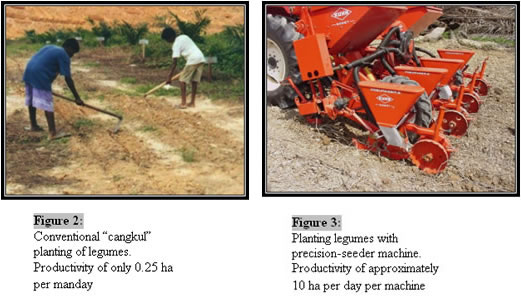
Prior to sowing of the legume seeds, ground preparation such as ploughing of legume beds with a tractor drawn disc-plough and harrowing is carried out (Figures 4 and 5)
. 

Legume establishment is expedited with applications of rock phosphate and ground magnesium limestones (Figures 6 and 7).



Oil Palm: Establishment
TOWARDS THE ESTABLISHMENT OF A GOOD OIL PALM PLANTING
Introduction
Legume planting
Holing and planting of palms
Weeding operations in immature oil palms
Costing
Concluding remarks
Oil palms are normally planted after land clearing and land preparation work, which includes lining, holing and terracing if the terrain is hilly. In low-lying areas, drainage would also be necessary. In most oil palm plantings, leguminous cover crops are also planted in the interrows as they are able to establish and spread much faster than other vegetation. The legumes should preferably be planted prior to planting the palms but in many instances, due to timing and other constraints, the oil palms are planted first.
The immaturity period of the palms, which would normally last approximately 30 – 36 months where ablation is done, begins from the moment of palm planting. In areas where no ablation is done, this is reduced to 24 months. Most planters would deem the immaturity period as the period where extensive field maintenance is required e.g. circle spraying, spot spraying, decreeping, manuring, pest control etc. to ensure not only high early yields be obtained, but also mature yields. This article highlights some of the work that a planter has to plan and carry out at the onset of oil palm planting particularly those related to legume establishment, holing and planting of the palms and the subsequent weeding operations. This article also complements the other two articles in the previous two issues of this annual report.

Reference
Ng H.C.P. and Tan C. C. 2003. Towards the establishment of a good oil palm planting. Annual Report 2002. Royal Johore Planters’ Association : 22-30.
Note: The full list of references quoted in this article is available from the above paper.
